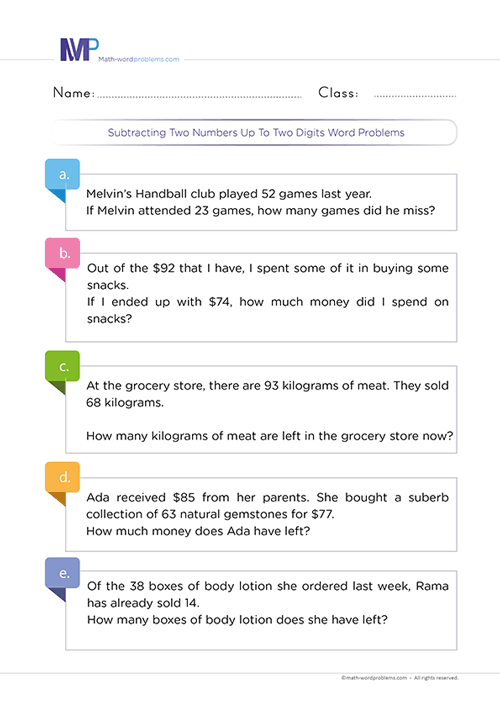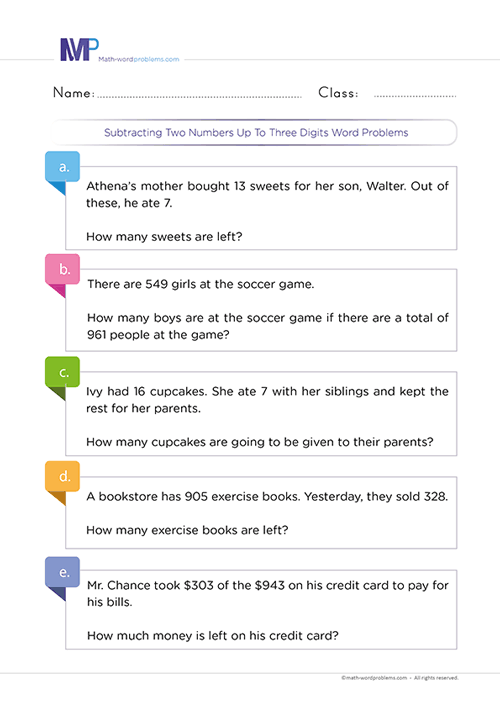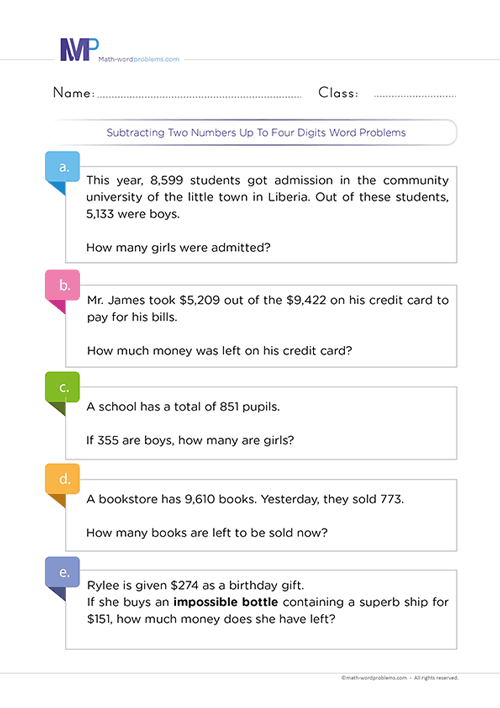 How do you subtract two numbers up to two digits word problems?
How do you subtract two numbers up to two digits word problems?

- INTRODUCTION
- Step 1 Identify
- Step 2 STRATEGIZE
- Step 3 SET UP
- Step 4 PROVIDE A SOLUTION
- Step 5 CHECK YOUR WORK
Get more contents on this skill...
A better way to learn how do you subtract two numbers up to two digits word problems is by engaging in this fun, remarkable resource. We will reinforce 3rd Graders' logical reasoning skills when tackling our subtraction problems.
Our interesting real-life examples with a systematic guide on solving subtraction problems will encourage kids always to create a complete mental representation of the problem composition and solve different but structurally similar problems.
In addition to this, our unique resource is very flexible in that if kids go through it, they will easily handle subtraction word problems containing varying attributes.
Steps on how to subtract two numbers up to four digits word problems
We are encouraging all 3rd Graders to grab the best of our steps on how to subtract two numbers up to four digits word problems and enjoy solving word problems on subtracting two numbers up to two digits efficiently.
Also, we have added practical examples to subtract two numbers up to two digits word problems below to demonstrate the effectiveness of these technical steps and how well they work.
Step 1 IDENTIFY THE PROBLEM
To identify the problem,
- Begin by reading the problem carefully to understand it.
- Then, identify and underline statements that are related.
- Now, reread the problem and try to sort out actual numbers and keywords in the problem.
Now when it is subtraction word problems, some of the keywords that you’ll come across in the word problem are:- less, minus, take away, left, decrease, difference, remain, change, how many more, how much more, how many left, how many fewer, were left, subtract, fewer, deduct, remove, etc.
Note: learners should understand that it would be best not to rely entirely on keywords alone because a particular keyword can have different meanings in different word problems.
In that case, you need to read the question very well to understand the situation the word problem describes. After reading, you will also find out if the problem makes sense first before determining which operation you need to use.
Step 2 STRATEGIZE AND DETERMINE THE OPERATIONS
Now, ask yourself, “How will I solve this problem?”
At this point, apply the read-to-understand rule. i.e.you must read the word problem and try to interpret it in your own words.
In addition, since each word problem may require a different format to solve, the key points below will enable you to tackle any word problem irrespective of the format.
- First, the keyword(s) in the word problem will help clarify the operation you need to carry out.
- But, relying on keywords alone to solve word problems has some limits, as mentioned in step 1 above.
- Now, you have to read the word problem to understand the situation that the problem is describing first.
- Understanding the situation that the problem is describing will enable you to identify the problem type and relational statement, which, together with the keyword(s) in the problem, will determine the accurate math operation that you need to use
Step 3 SET UP A NUMBER SENTENCE AND AN EQUATION
- After knowing which operation you will perform from step 2 above, construct short sentences to represent the information given in the word problem.
- These short sentences represent the vital information that makes it easier to solve the word problem. In order words, it is like a diagram of the word problem.
- After that, you can now deuce a solvable maths equation to represent the information given in the sentences that you constructed above.
Step 4 SOLVE THE PROBLEM
After writing down the maths equation, you can solve the problem using any subtraction method, preferably the column method. Besides this, don’t forget to include the unit of measurement in your final answer.
Step 5 VERIFY YOUR ANSWER
Finally, check your work to make sure that your answer is correct. For instance, since you are dealing with only numbers and not algebraic expressions, it is good to use reasonableness by estimation to see if your answer makes sense.
Therefore, if you estimate and the answer is close to what you have, your answer is correct. However, if your answer is beyond reasonable limits, you must go back to step one and start again.
Examples of how to subtract two numbers up to two digits word problems
Example One
Step 1:First, read the problem and underline all the relational statements. You see that the critical numbers you will find after reading the problem are 73 and 19. Also, the keyword in the word problem is “left.”
Step 2:Now, how are you going to solve this problem?
First, read and retell the problem in your own words to come out with the correct operation.
The problem is that Mr. Brook has a certain number of comic books in his store. Yesterday, he sold a certain number out of the original number of comic books in his store.
So, the problem wants you to find the number of comic books left in the store after he sold some.
Therefore, with this scenario of the problem, the question you should be asking yourself is:- “which operation can I use to find out what is remaining after removing a certain number of items from the original number of that same item?”
So you see that, from the situation that the problem is describing, from retelling the problem in your own words, and from the keyword “left” found in the word problem calls for you to perform a subtraction operation.
Step 3:Construct short sentences representing the most vital information in the word problem.
Also, write down a solvable maths equation to represent the information given in the sentence that is in bold below.
- Number of comic books in the store = 73
- Number of comic books he sold = 19
- Therefore, the number of comic books left in the store now = the number of comic books in the store - the number of comic books he sold.
→ 73 – 19 = ?
Step 4: From step 3 above, stack the values in the equation you formed so that their place values should line up. You can solve the problem using any subtraction method, preferably the column method. Also, it would help if you always remember to include the unit of measurement in the final result.
So, 54 comic books are left in his store
Step 5:Finally, check your work to ensure your answer is correct. Since you are dealing with only numbers and not algebraic expressions, it is good to use reasonableness by estimation to see if your answer makes sense.
So, if you estimate and the answer is close to the one you have, then your answer is correct. However, if your answer is beyond reasonable limits, you must go back to step one and start again.
Example Two
Step 1: First, read the problem and underline all the relational statements. You see that the important numbers you will find after reading the problem are 15 and 24. Also, the keyword you will find in the word problem is “how many more.”
Step 2: Now, how are you going to solve this problem?
First, read and retell the problem in your own words to come out with the correct operation without necessarily depending on the keyword.
The problem says there is a certain number of birds sitting on a cable line, but a certain number of more birds flew and joined, and now the original number of birds sitting on the cable line has changed.
So, the problem wants you to find the number of birds that flew to join the original number of birds sitting on the cable line.
This, given the problem scenario, the question you should ask yourself is. “which operation can I use to find out a certain number of things that when I add to an already existing number of things, I will get the total present number of things?”
You see that, from the situation that the problem is describing, from retelling the problem in your own words, and from the keyword “how many more” found in the word problem calls for you to perform no other operation than a subtraction operation.
Step 3:Construct short sentences representing the most vital information in the word problem.
Also, write down a solvable maths equation representing the information given in the sentence that is in bold below.
- Number of birds that were sitting on the cable line = 15
- Number of birds sitting on the cable line when some more birds flew up to the cable line = 24
- Therefore, the number of birds that flew up to the cable line = the number of birds sitting on the cable line when some more birds flew up the cable line - the number of birds that were sitting on the cable line.
→ 24 – 15 = ?
Step 4: From step 3 above, stack the values in the equation you formed so that their place values should line up. You can solve the problem using any subtraction method, preferably the column method. Also, it would help if you remembered always to add the unit of measurement to the final result.
So, 9 more birds flew up to the cable line
Step 5: Finally, check your work to ensure your answer is correct. Since you are dealing with only numbers and not algebraic expressions, it is good to use reasonableness by estimation to see if your answer makes sense.
So, if you estimate and the answer is close to the one you have, then your answer is correct. However, if your answer is beyond reasonable limits, you must go back to step one and start again.





